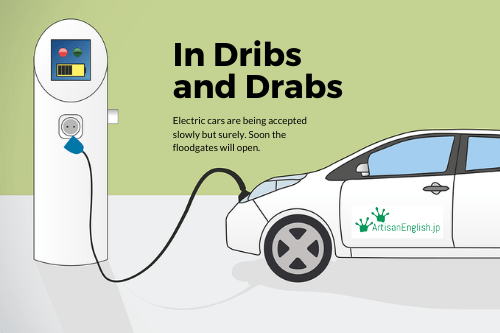
(Photo: Pixaline/Pixabay | Text: David/ArtisanEnglish.jp)
YouTube / iTunes / Spotify / Radio Public / Pocket Casts / Google Podcasts / Breaker / Overcast
Listen to ArtisanEnglish.jp posts & lesson intros here.
Phrase: In dribs and drabs
The future holds some enormous changes for Japan.
The challenge is that Japan doesn’t like to change.
Well, it doesn’t like dramatic and sudden change.
Japan prefers change to occur in dribs and drabs.
That means change occurs a little bit at a time in small amounts.
There’s nothing too dramatic, and that’s why the economy has not been doing so hot lately.
China’s rapid industrialization and development of precise manufacturing skills signalled a period sometimes referred to as ‘Japan Passing.’
It didn’t happen all at once but snuck up on Japan very quietly.
China rapidly improved its manufacturing capabilities and the sophistication of its transportation networks.
Then Japanese companies moved their factories to China to take advantage of the lower salaries, and the maneuver was complete – China passed Japan.
Until the pandemic upended the world, Japan had been reluctant to accept technological advances into its way of doing business.
The tech it did accept was adopted in dribs and drabs.
Like or follow ArtisanEnglish.jp on social media.
Now, while the rest of the world is switching to remote work and electric cars, Japan has been held back by honkos and a failure to read the tea leaves.
Persona’s transplantation to Awaji Island was a foreshadowing of things to come.
The days of adopting new tech and working styles in dribs and drabs in Japan must end, or it will be passed by again.
Regarding transportation, the world is Going Electric, and the only Japanese automaker with an acceptable electric car is, believe it or not, Nissan.
Yes, the days of accepting change in dribs and drabs must end in Japan.
Tremendous technological change is around the corner, and Japan must decide to embrace it.
The days of dribs and drabs are over.
Flesch-Kincaid Readability Test
This post is understandable by someone with at least an 8th-grade education (age 13 – 14).
On the Flesch-Kincaid reading-ease test, this post scores 62.
The easier a passage is to read, the higher the score on a scale of 0 – 100.

